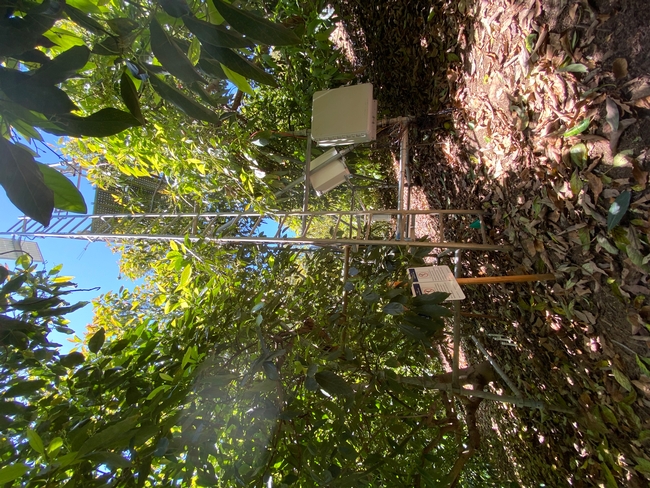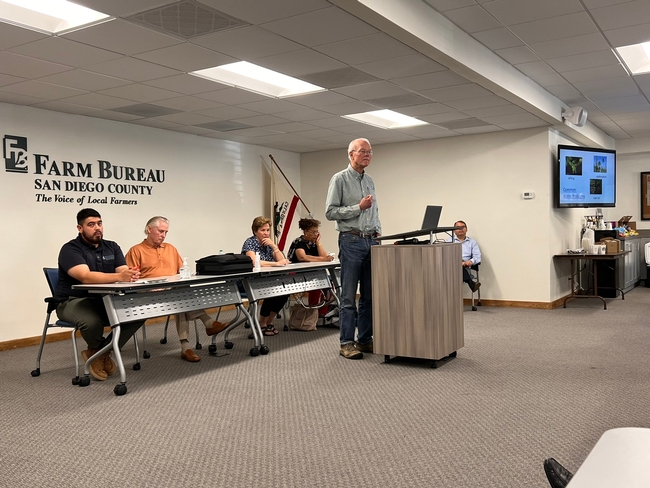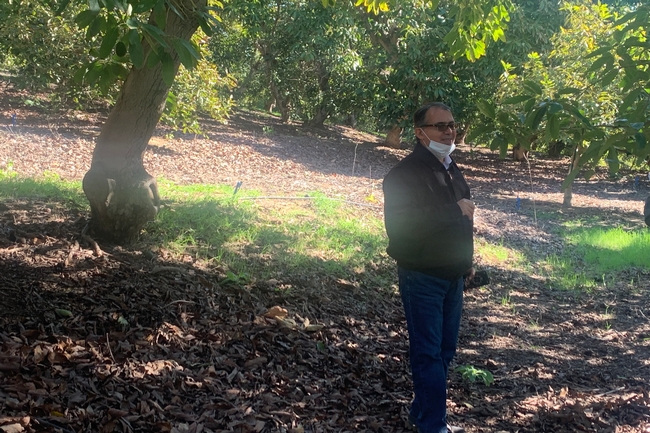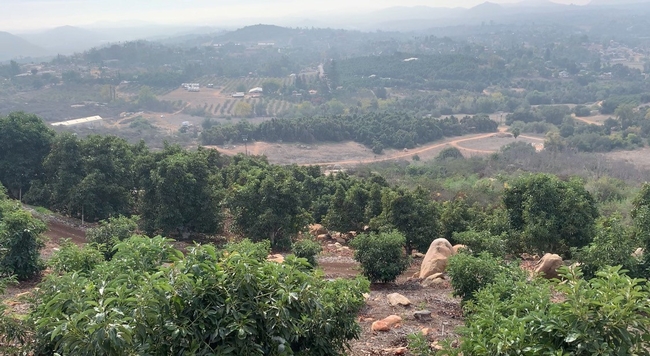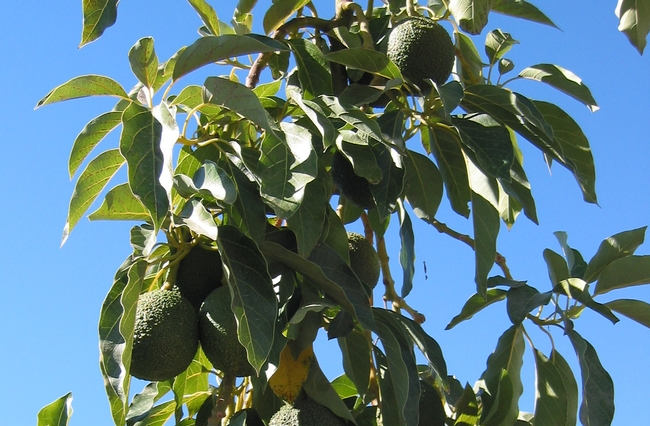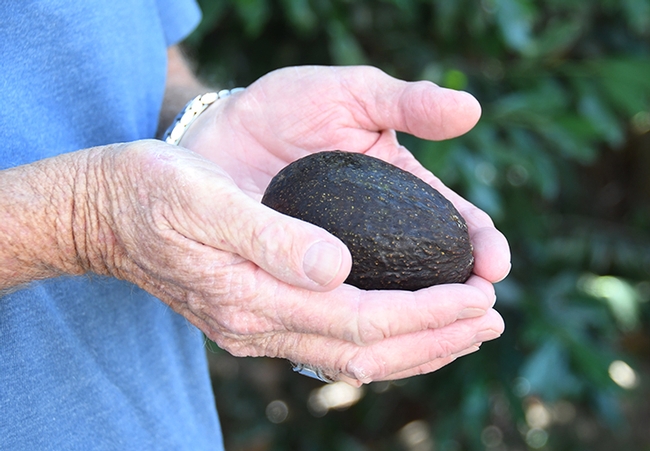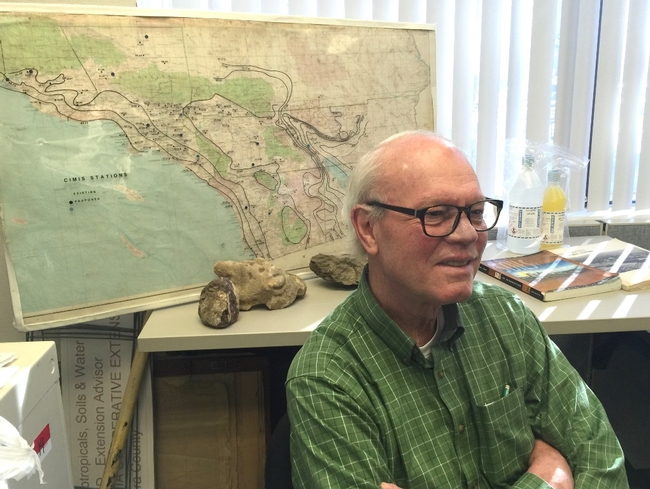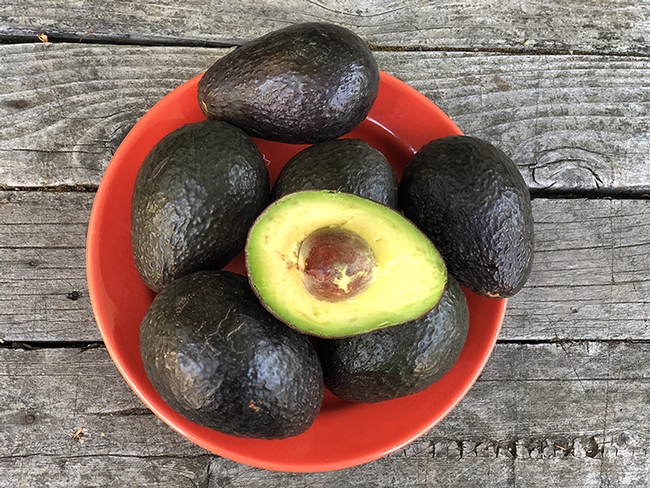Posts Tagged: avocado
San Diego avocado growers look to Cooperative Extension experts to manage water costs
San Diego County used to be home to nearly 25,000 acres of avocado trees but today there are about 14,000. The drastic decrease is largely due to rising costs associated with avocado production, namely the cost of water.
On September 28, avocado growers gathered at the San Diego County Farm Bureau offices for an Avocado Irrigation Workshop facilitated by Ali Montazar, University of California Cooperative Extension irrigation and water management advisor for Imperial, Riverside and San Diego counties.
“All of our information being developed right now is focused on [irrigation] efficiency. Growers want to know how much water they need and what tools they should use to be more efficient,” explained Montazar.
“The sophisticated research in avocado irrigation that Dr. Ali Montazar is conducting is the first of its kind that the University of California has carried out specifically in avocados. His presentation allowed us attendees the opportunity to see and learn about the technology he is employing – from soil moisture sensors to the California Irrigation Management Information System level equipped station.”
Burr is hopeful that Montazar's research will help avocado growers accurately determine the evapotranspiration in an avocado grove or water use specific to avocados, critical parts of how growers select tools to determine irrigation runtimes.
“His presentation that showed his research finding of the avocado Kc (crop coefficient), while very early into his project, was really interesting. It indicates the possibility that we may need to vary the Kc for different times in the growing season, but he is just beginning a two-to-three-year project that will hopefully deliver solid data on what the Kc for avocados is,” said Burr.
Colorado River uncertainty looms
San Diego's avocado production is primarily managed by small farms. According to Montazar, this adds a level of complexity to water management because there is a greater emphasis on irrigation tools and strategies being user-friendly and cost-efficient.
“We don't know the future,” said Montazar. “But we need to be prepared for all consequences. The Colorado River is experiencing a significant water shortage, and this could impact the water supply source for San Diego County from the Imperial Irrigation District Transfer in the future. It is wise to consider enhancing irrigation efficiency as the most viable tool to manage limited water supplies in Southern California.”
Water has always been an issue. In the 1970s, California's water program paved a way for an additional 98,000 acres of agricultural land.
According to a 1970 study analyzing the cost of avocado production in San Diego County, water costs “averaged 3½ acre feet per acre at $60 an acre foot,” which came with the assumption that water costs would remain relatively low and affordable for a long time.
Unfortunately, that is no longer the case. The county of San Diego gets the majority of its water from the Colorado River, which is concerning given five-year projections of the river reaching critically low reservoir levels by 2027.
In fact, beginning in 2023, the San Diego County Water Authority will be raising the rates for water, prompting growers to invest in more efficient irrigation practices (Table 1).
Table 1. Cost for untreated and treated water in San Diego County in 2022 and 2023.
NOTE: An acre-foot is about 325,900 gallons of water.
Training growers on irrigation a top priority
There are no loopholes or short cuts when it comes to irrigation because irrigation is the key to tree health. Ben Faber, Cooperative Extension subtropical crops advisor for Ventura and Santa Barbara counties, points out that tree health is how growers stay in business.
“You can mess up your fertilization program, and you can mess up your pesticide program, but if you mess up your irrigation program, you're out of business,” he said.
According to Faber, efficient irrigation requires a strong grasp on salt management.
“We import water that has a lot of salt in it. So, you've got to figure out how to put the right amount of water on the root zone without causing root health problems,” said Faber.
This process requires meticulous care, as anything that gets below the root zone can cause groundwater contamination – something growers do not want to be responsible for.
While the latest irrigation technology, such as smart controllers, could help growers, Faber said that training and educating farm managers should be the priority.
As Faber puts it, managing irrigation should be “like brushing your teeth” – something that growers do naturally and competently. Many growers are over-irrigating or wasting time trying to resuscitate dying trees. It's important to learn the needs of the tree and, in some cases, it might be best to stop watering all together.
The first step to water efficiency is acquiring knowledge and identifying needs. Because an over-irrigated tree looks just like an under-irrigated tree, it's crucial that growers learn to recognize the difference and plan accordingly.
This is where Cooperative Extension advisors and researchers come in. Opportunities like the Avocado Irrigation Workshop are ideal for growers looking for answers or support.
For more information and to learn about future workshops in San Diego County, visit https://cesandiego.ucanr.edu/.
Avocado growers to get irrigation tools, strategies from UC ANR’s Montazar
CDFA grant supports research to optimize water use for iconic California crop
California growers, who account for more than 90% of avocado production in the U.S., will soon be getting some help in weathering the extreme fluctuations of climate change.
Ali Montazar, a University of California Cooperative Extension irrigation and water management advisor, recently received a grant to develop tools and strategies that optimize growers' irrigation practices across Southern California – the state's avocado belt. California avocados are valued at more than $411 million, according to the National Agricultural Statistics Service.
“This region faces uncertain water supplies, mandatory reductions of water use, and the rising cost of water – while efficient use of irrigation water is one of the highest conservation priorities,” Montazar said. “Water is the most critically important input to avocado production.”
At the California Avocado Commission's suggestion, Orange County was added to the study to better capture the range of climates and cropping systems across the region, Montazar said.
He hopes to develop “crop coefficients” that avocado growers can use to determine the optimal irrigation for their crop based on a host of factors: soil type and salinity, canopy features, row orientation, slopes, soil and water management practices, and more.
“Growers are unclear on how much water the crop actually needs under those conditions,” Montazar said.
He will incorporate data from the actual water use in the experimental orchards – including information from the newest soil moisture and canopy temperature sensors – to help ensure growers do not under- or overwater their crops. Overirrigating contributes to a devastating disease, avocado root rot, caused by the plant pathogen Phytophthora cinnamomi.
Another component of the grant supports outreach in disseminating these resources and best practices to the broader agricultural community.
“Developing and adopting these tools and information may have a significant impact on water quality and quantity issues and bolster the economic sustainability of avocado production not only in the well-established production region of Southern California, but also in Kern and Tulare counties where new avocado plantings are growing,” Montazar said.
Preliminary findings and recommendations are expected at the end of 2022.
Study finds 82 percent of avocado oil rancid or mixed with other oils
Consumer demand is rising for all things avocado, including oil made from the fruit. Avocado oil is a great source of vitamins, minerals and the type of fats associated with reducing the risk of heart disease, stroke and diabetes. But according to new research from food science experts at the University of California, Davis, the vast majority of avocado oil sold in the U.S. is of poor quality, mislabeled or adulterated with other oils.
In the country's first extensive study of commercial avocado oil quality and purity, UC Davis researchers report that at least 82% of test samples were either stale before expiration date or mixed with other oils. In three cases, bottles labeled as “pure” or “extra virgin” avocado oil contained near 100 percent soybean oil, an oil commonly used in processed foods that's much less expensive to produce.
“I was surprised some of the samples didn't contain any avocado oil,” said Selina Wang, UC Cooperative Extension specialist in the UC Davis Department of Food Science and Technology, who led the study recently published in the journal Food Control.“Most people who buy avocado oil are interested in the health benefits, as well as the mild, fresh flavor, and are willing to pay more for the product. But because there are no standards to determine if an avocado oil is of the quality and purity advertised, no one is regulating false or misleading labels. These findings highlight the urgent need for standards to protect consumers and establish a level playing field to support the continuing growth of the avocado oil industry.”
Testing domestic and imported brands
Wang and Hilary Green, a Ph.D. candidate in Wang's lab, analyzed various chemical parameters of 22 domestic and imported avocado oil samples, which included all the brands they could find in local stores and online. Wang and Green received a $25,000 grant from Dipasa USA, part of the Dipasa Group, a sesame-seed and avocado-oil processor and supplier based in Mexico.
“In addition to testing commercial brands, we also bought avocados and extracted our own oil in the lab, so we would know, chemically, what pure avocado oil looks like,” Wang said.
Test samples included oils of various prices, some labeled extra virgin or refined. Virgin oil is supposed to be extracted from fresh fruit using only mechanical means, and refined oil is processed with heat or chemicals to remove any flaws.
Fifteen of the samples were oxidized before the expiration date. Oil loses its flavor and health benefits when it oxidizes, which happens over time and when exposed to too much light, heat or air. Six samples were mixed with large amounts of other oils, including sunflower, safflower and soybean oil.
Only two brands produced samples that were pure and non-oxidized. Those were Chosen Foods and Marianne's Avocado Oil, both refined avocado oils made in Mexico. Among the virgin grades, CalPure produced in California was pure and fresher than the other samples in the same grade.
A push for standards
Ensuring quality is important for consumers, retailers, producers and people throughout the avocado oil industry. Retailers want to sell quality products, shoppers want to get their money's worth and honest producers want to keep fraudulent and low-quality oil out of the marketplace.
But since avocado oil is relatively new on the scene, the Food and Drug Administration (FDA) has not yet adopted “standards of identity,” which are basic food standards designed to protect consumers from being cheated by inferior products or confused by misleading labels. Over the last 80 years, the FDA has issued standards of identity for hundreds of products, like whiskey, chocolate, juices and mayonnaise. Without standards, the FDA has no means to regulate avocado oil quality and authenticity.
Avocado oil isn't the only product without enforceable standards. Honey, spices and ground coffee are other common examples. Foods that fetch a higher price are especially ripe for manipulating, especially when adulterations can be too subtle to detect outside a lab.
Wang is working to develop faster, better and cheaper chemical methods to detect adulteration so bulk buyers can test avocado oil before selling it. She is also evaluating more samples, performing shelf-life studies to see how time and storage affects quality, and encouraging FDA officials to establish reasonable standards for avocado oil.
Wang has experience collaborating with industry and the FDA. Ten years ago, she analyzed the quality and purity of extra virgin olive oil and discovered that most of what was being sold in the U.S. was actually a much lower grade. Her research sparked a cascade of responses that led California to establish one of the world's most stringent standards for different grades of olive oil. The FDA is working with importers and domestic producers to develop standards of identity for olive oil.
“Consumers seeking the health benefits of avocado oil deserve to get what they think they are buying,” Wang said. “Working together with the industry, we can establish standards and make sure customers are getting high-quality, authentic avocado oil and the companies are competing on a level playing field.”
Tips for consumers
- The flavor of virgin avocado oil can differ by varieties and region. In general, authentic, fresh, virgin avocado oil tastes grassy, buttery and a little bit like mushrooms.
- Virgin avocado oil should be green in color, whereas refined avocado oil is light yellow and almost clear due to pigments removed during refining.
- Even good oil becomes rancid with time. It's important to purchase a reasonable size that can be finished before the oil oxidizes. Store the oil away from light and heat. A cool, dark cabinet is a good choice, rather than next to the stove.
- How do you know if the oil is rancid? It starts to smell stale, sort of like play dough.
- When possible, choose an oil that's closest to the harvest/production time to ensure maximum freshness. The “best before date” is not always a reliable indicator of quality.
Why 'AA' is for Avocado Addict
If you're like most of us, you “go bananas” for a banana for breakfast.
It's healthy, nutritious and packed with potassium.
But wait! You should probably go bananas for another fruit--that pear-shaped avocado. Did you know the avocado provides more potassium than a banana?
It does. A medium-sized banana yields 422 milligrams of potassium, while a medium-sized avocado, a whopping 708 milligrams.
Dietitian Linda W. Adams of UC Davis Occupational Health Services (among her responsibilities: teaching a 52-week UC Davis Diabetes Prevention Program) says “I think my favorite part about avocados, in addition to their wonderful flavor, is that they are full of monounsaturated, heart-healthy fat AND have more potassium than bananas! These two nutrients are lacking in many Americans' diets.”
“Eating more unsaturated fats -- as opposed to saturated fats and processed carbohydrate -- is a delicious step we all can take to maximize cardiovascular health,” Adams says. “Avocados are such a delicious way to do that!"
We love our avocados, our veritable green goddess that never disappoints, never deceives, never dissatisfies, whether we “butter” them on toast in the morning for breakfast, or slice or chunk or cube them for our salads at lunch and dinner. Health-conscious folks call them a superfood, and even mash and freeze them to ensure a steady supply in the winter. There's even a website on “50 Things to Love About Fresh Avocados.”
This year, California's 2000 avocado growers anticipate a yield of 374.6 million pounds. That crop forecast, according to Tom Bellamore, president of the California Avocado Commission, is nearly double the yield of the 2017 crop and “despite the ravages of Mother Nature in California's avocado growing regions.”
UC Cooperative Extension adviser and avocado researcher Ben Faber of Ventura and Santa Barbara counties, points out that the avocado is really a fruit, not a vegetable. “The Supreme Court classified the tomato in 1920 or so as a vegetable because that's the way people think of it and it was taxed differently for tariffs. Politics or botany separates a lot of things in our lives.”
“The avocado is an amazing fruit,” Faber says. “It grows on a tree and comes to maturity, reaches certain oil content and a stage at which it will ripen, but it does not ripen on the tree. It needs to be removed from the tree before it will soften. If the fruit is removed before it has reached maturity it will not soften, and will remain rubbery and inedible.”
“One of the problems is that the fruit will hang on the tree for an extended period of time and it is hard to know when they are mature,” Faber points out. “Avocados are not like apricots where you have about two weeks to get the fruit off before it falls off. As the fruit stays on the tree, it gradually develops more and more oil content and has a richer flavor.”
What if the fruit stays on the tree too long? “It can develop an almost rancid flavor,” Faber says. “So it is good to know when the best, acceptable flavor is. Avocado varieties fall into general seasonal periods when they are mature, such as ‘Fuerte' and ‘Bacon' in winter, ‘Hass' in spring/summer, ‘Lamb-Hass' in summer/fall.”
The fruit will typically be ripe in seven to ten days, Faber advises. “If you want to speed things along a bit you can take three or four avocados and place them in a loosely closed paper bag with two or three Red or Golden Delicious apples or ripe kiwifruit. The purpose of the apples or kiwifruit is that these fruit produce a natural plant hormone, ethylene, that will help stimulate the avocado to produce its own ethylene. Apples and kiwifruit are known to produce lots of ethylene. The Delicious apples are varieties that produce more ethylene than other apple varieties. You can keep them even after they are shriveled and they will be producing ethylene.”
Never place your avocados in a plastic bag “unless you keep it open since the fruit needs to breathe during this process,” he says. “Just keep the fruit on your kitchen counter or in a warm place; 68F is the ideal temperature. Lower and higher temperatures both actually slow the process.”
Plant scientists trace the origin of the avocado (Persea americana) to south central Mexico. The avocado belongs to the flowering plant family, Lauraceae. Growers and gardeners glean tips on pest management from the industry and from the UC Statewide Integrated Pest Management Program.
Of the many known varieties, avocados fall into three broad categories based on whether they are of the Mexican, Guatemalan or West Indian races of Persea americana, the avocado species and the crosses that occur between these races. Generally speaking, California varieties have been the result of crossing between the Mexican and Guatemalan races. West Indian race varieties are not common here because of their generally lower cold tolerance.”
Ben Faber, like Linda W. Adams, enjoys avocados. He usually buys them “whenever they are reasonably priced.”
“One of the reasons I do research is that all the downed fruit is not salable because it is against food safety restrictions to introduce it into the food chain and all that fruit either gets eaten by coyotes or me,” he quips, adding “The tree is too big to fit into my backyard.”
Looking for a great recipe? The California Avocado Commission offers many recipes, including what it calls “The Best Guacamole Ever."
Dietitian Adams shares one of her favorites at https://www.delish.com/cooking/recipe-ideas/a19872947/avocado-tomato-salad-recipe/.
Avocado Tomato Salad
Ingredients
1/4 cup extra-virgin olive oil
Juice of 1 lime
1/4 tsp. cumin
Kosher salt
Freshly ground black pepper
3 avocados, cubed
1 pint cherry tomatoes, halved
1 small cucumber, sliced into half moons
1/3 cup corn
1 jalepeño, minced (optional)
2 tbsp. chopped cilantro
Directions
In a small bowl, whisk together olive oil, lime juice, and cumin. Season with salt and pepper.
In a large serving bowl, combine avocados, tomatoes, cucumber, corn, jalapeño, and cilantro. Gently toss with dressing and serve immediately.
Enjoy! The avocado keeps good company!


